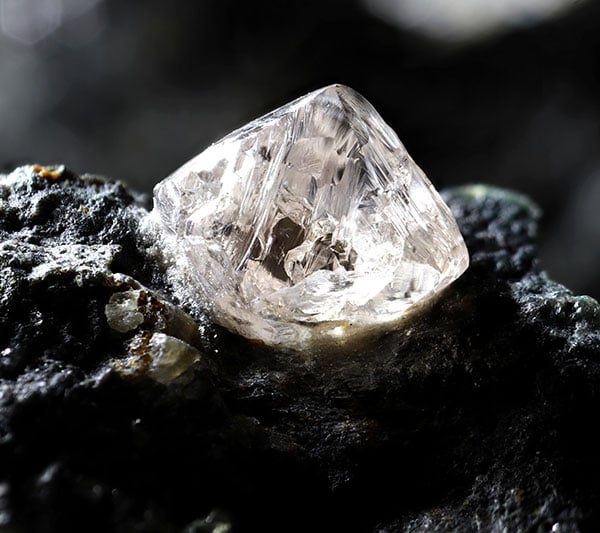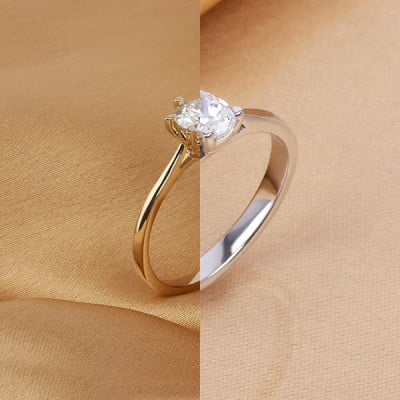How Are Diamonds Formed?
29th December 2021 By Nilesh Rakholia
Quicklinks
When you look down at your diamond ring or admire your diamond earrings or necklace in the mirror, you probably don’t think about how these diamonds formed, and where they were created. Diamonds are millions of years old, naturally made within the Earth. These scientific wonders have puzzled scientists for centuries, and there is still a lot unknown about them. Luckily, we have put together a guide to help you see how diamonds are formed - from deep within the Earth to taking crowning glory on your favourite piece of jewellery.
Natural Diamond Formation
Diamonds are initially made in the Earth’s mantle – this is the layer below the Earth’s crust. The mantle is around 100 miles under the Earth, and it is believed that temperatures in the mantle can be around 900 to 1,300 degrees Celsius, and pressures of up to 725,000 pounds per square inch. Under these extreme conditions, elements can bond and shift to create new substances.
This is where diamonds come in. Whilst many believe diamonds are made from coal, this isn’t true, as diamonds first formed before coal existed. Diamonds are actually made from Carbon. Since Carbon is a common element in coal, this can lead to confusion.
When Carbon is subjected to extreme conditions in the Earth’s mantle, it begins to bond together and crystalise. This crystalised substance grows as more and more carbon atoms attach, creating an ever-growing diamond.
It isn’t quite known how long diamonds take to make. Most diamonds were formed millions, if not billions of years ago as the Earth was hotter, allowing Carbon to crystalise easily.
It is also believed that diamonds could form from collisions with the Earth. Russia claims that they have a large deposit of diamonds due to an asteroid collision around 35 million years ago. Again, it is believed that the heat and pressure created through the collision caused Carbon atoms to begin to crystalise like in the mantle.
How Are Diamonds Found?

Whilst diamonds are made in the Earth’s mantle, it would be impossible for humans to discover them down there since humans wouldn’t be able to survive under these conditions. Luckily, diamonds can be transported closer to the Earth’s surface.
Again, millions of years ago, it is believed there were huge eruptions within the Earth’s mantle that pushed diamonds to the Earth’s crust. Due to the extreme heat and pressure in the mantle, large volcanic eruptions occurred underground. These eruptions held such a force that they pushed other substances up towards the Earth’s crust, including diamonds.
Once diamonds were settled in the Earth’s crust, they were much easier to find. Modern mining practices that dug into the crust meant that miners stumbled across diamonds allowing them to become jewellery essentials.
Again, millions of years ago, it is believed there were huge eruptions within the Earth’s mantle that pushed diamonds to the Earth’s crust. Due to the extreme heat and pressure in the mantle, large volcanic eruptions occurred underground. These eruptions held such a force that they pushed other substances up towards the Earth’s crust, including diamonds.
Once diamonds were settled in the Earth’s crust, they were much easier to find. Modern mining practices that dug into the crust meant that miners stumbled across diamonds allowing them to become jewellery essentials.
How Old Are Diamonds?
It isn’t exactly known just how old diamonds are, but they’re believed to be billions of years old. Scientists can use radioactive dating to help find the approximate age of a diamond. When diamonds form, minerals and other substances usually get trapped inside.
These minerals can be dated by scientists, helping them to see how old diamonds are. Whilst some newer diamond deposits are thought to be around a few hundred million years old, it is believed that the vast majority were made billions of years ago.
Synthetic Diamonds
Now that scientists know more about how diamonds are made, they have been able to mimic this process and create their own diamonds. This process begins by using a diamond ‘seed’, which is a tiny shaving taken from a naturally occurring diamond.
Using this diamond seed, scientists then emulate the conditions within the Earth’s mantle. A machine called a growth chamber is able to produce excessive amounts of heat and pressure, like those found in the mantle, that allows the diamond seed to grow into a larger diamond chunk. The seed is left for around 28 days before the larger diamond piece is extracted.
When looking at a diamond, it is easy to get lost in its beautiful sparkle, but we mustn’t forget the incredible journey they have gone through to make it onto our jewellery. Whilst still a lot remains unknown, what we do know proves just how incredible diamonds really are, and how we mustn’t take them for granted.
If you’re looking for a beautiful piece of diamond jewellery, ABELINI has you covered with a stunning selection of hand-crafted jewellery.

Article written by Nilesh
 Trustpilot
Trustpilot



